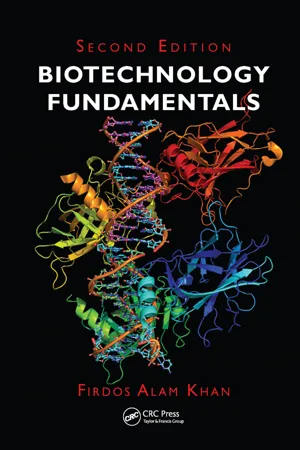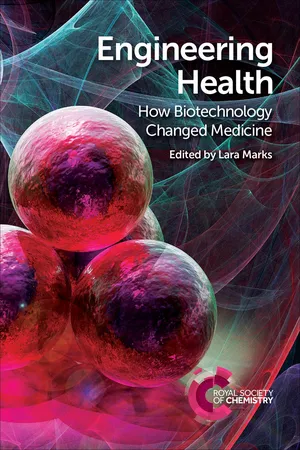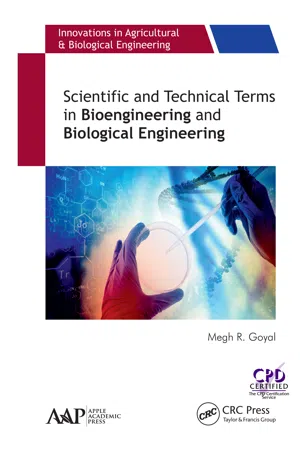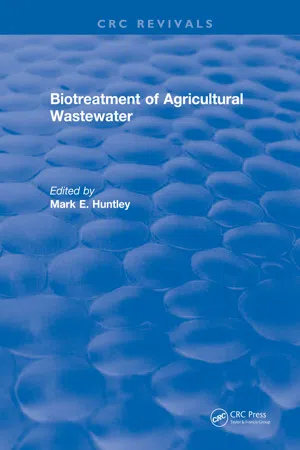Biological Sciences
Biotechnology
Biotechnology involves the use of biological systems, organisms, or derivatives to develop products and technologies that benefit society. It encompasses a wide range of applications, including genetic engineering, pharmaceuticals, agriculture, and environmental management. By harnessing the power of living organisms, biotechnology has the potential to address various challenges and improve human well-being.
Written by Perlego with AI-assistance
Related key terms
6 Key excerpts on "Biotechnology"
- eBook - ePub
Pharmacognosy
Fundamentals, Applications and Strategies
- Rupika Delgoda, Simone Badal McCreath(Authors)
- 2016(Publication Date)
- Academic Press(Publisher)
[4] in the United States describes modern Biotechnology as incorporating “a specific focus on industrial usage of recombinant deoxyribonucleic acid (rDNA), cell fusion, and novel bioprocessing techniques; industrial use of living organisms.”Biotechnology is therefore a multidisciplinary and interdisciplinary field, rather than a single discipline, that has given rise to a range of products and processes in life sciences. The technology has been applied to the development of new medicines, improved crop plants and animals, as well as the more efficient manufacture of everyday products. A color code was created to distinguish between the various applications. Red, green, white, and blue Biotechnology refer to applications to medicine, agriculture, industry, and marine and aquatic environments, respectively; these are further explained in later sections of the chapter.28.2 Biotechnology, Bioengineering, and Biomedical Engineering
Depending on the tools and applications, there is notable overlap with biomedical engineering or bioengineering and Biotechnology [5 ,6] . Biomedical engineering or bioengineering is a rapidly growing transdisciplinary field that is regarded as the bridge between technology, medicine, and biology. In other words, the primary focus of bioengineering is the application of the principles of engineering and design concepts to medicine and biology. Harmon in 1975 defined bioengineering as the “field that uses the tools and concepts of the physical sciences to analyze biological systems” [7] . In 1997, the US National Institutes of Health (NIH) published its working definition: “Bioengineering integrates physical, chemical, or mathematical sciences and engineering principles for the study of biology, medicine, behavior, or health; it advances fundamental concepts, creates knowledge form the molecular to the organ systems levels, and develops innovative biologics, materials, processes, implants, devices, and informatics approaches for the prevention, diagnosis, and treatment of disease, for patient rehabilitation, and for improving health” [8] . Although NIH’s definition of bioengineering is focused on human health, which is a key component of biological engineering, bioengineering also addresses the full spectrum of life sciences, including applications to agricultural, environmental, and ecological systems [9] - eBook - ePub
- Firdos Alam Khan(Author)
- 2020(Publication Date)
- CRC Press(Publisher)
- The use of living organisms or their products to make or modify a substance. Biotechnology includes recombinant DNA (deoxyribonucleic acid) techniques (genetic engineering) and hybridoma technology.
- A set of biological techniques developed through basic research and applied to research and product development.
- The use of cellular and biomolecular processes to solve problems or make useful products.
- An industrial process that involves the use of biological systems to make monoclonal antibodies and genetically engineered recombinant proteins.
- Development of 3D organs or tissues under in vitro conditions
We should not debate on which of the given definitions is true because all of them are true in their respective ways. For example, if you ask a farmer about what Biotechnology is, he or she may say, “Biotechnology is to produce high yield or pest-resistant crops.” If you pose the same question to a doctor, he or she may say, “Biotechnology is about making new vaccines and antibiotics.” If you ask the question to an engineer, he or she may say, “Biotechnology is about designing new diagnostic tools for better understanding of human diseases,” and if you ask the question to a patient suffering from Parkinson’s disease, he or she may say “Biotechnology is about stem-cell-based therapy and has tremendous capability to cure Parkinson’s disease.” All of these different definitions of Biotechnology suggest that Biotechnology has immensely impacted our daily life with arrays of products. As the field of Biotechnology keeps expanding, efforts are being made to subclassify this field into various types. The field of Biotechnology may be broadly subclassified into animal, plant, medical, industrial, and environmental Biotechnology. Nonetheless there are other emerging fields of Biotechnology, such as regenerative medicine (Figure 1.2 ), biosimilars, pharmacogenomics, bioinformatics, therapeutic proteins, forensic science, synthetic biology, bio-robotics, and biomimetics which we have separately discussed in Chapter 12 - eBook - ePub
- Firdos Alam Khan(Author)
- 2018(Publication Date)
- CRC Press(Publisher)
• The use of living organisms or their products to make or modify a substance. Biotechnology includes recombinant DNA techniques (genetic engineering) and hybridoma technology.• A set of biological techniques developed through basic research and applied to research and product development.• The use of cellular and biomolecular processes to solve problems or make useful products.• An industrial process that uses biological systems to make monoclonal antibodies and genetically engineered recombinant proteins.We should not debate on which of the given definitions is true because all of them are true in their respective ways. For example, if you ask a farmer what Biotechnology is, he or she may say “Biotechnology is to produce high-yield or pest-resistant crops.” If you pose the same question to a doctor, he or she may say “Biotechnology is about making new vaccines and antibiotics.” If you ask an engineer, he or she may say “biotechnol-ogy is about designing new diagnostic tools for better understanding of human diseases,” and if you ask a patient suffering from Parkinson’s disease, he or she may say “Biotechnology is about stem-cell-based therapy and has tremendous capability to cure Parkinson’s disease.” All these different definitions of Biotechnology suggest that Biotechnology has immensely influenced our daily life with arrays of products. As the field of Biotechnology keeps expanding, efforts are being made to subclassify this field into various types. The field of Biotechnology may be broadly sub-classified into animal, agricultural, medical, industrial, and environmental Biotechnology.1.2 Animal Biotechnology
Animal Biotechnology is the application of scientific and engineering principles to the processing or production of materials from animals or aquatic species to provide research models and to make healthy products. Some examples of animal Biotechnology are generation of transgenic animals (animals with one or more genes introduced by human intervention), use of gene knockout technology to generate animals with a specified gene inactivated, production of nearly identical animals by somatic cell nuclear transfer (also referred to as clones), - eBook - ePub
Engineering Health
How Biotechnology Changed Medicine
- Lara Marks(Author)
- 2017(Publication Date)
- Royal Society of Chemistry(Publisher)
CHAPTER 1Introduction: Biotechnology—An Ever Expanding Toolbox for Medicine1LARA V. MARKSUniversity College London, UKEmail: [email protected]1.1 INTRODUCTION
Biotechnology is intrinsic to medicine. Everywhere you look today, from medical research conducted in the laboratory through to the diagnosis and clinical treatment of a patient, Biotechnology is pivotal to that process. Despite its importance, few non-scientists understand what Biotechnology is, where it has come from or the many different functions it serves in everyday healthcare.The term Biotechnology was first coined in 1919 by Károly Ereky, a Hungarian agricultural engineer and economist. At its most basic level Biotechnology refers to the controlled and deliberate manipulation of organisms and living cells to create products for the benefit of humans. In one form or another, humans have deployed Biotechnology for thousands of years. Since prehistoric times, for example, they have used yeast to get bread dough to rise and to produce alcoholic drinks. Bacteria have also been added to milk for generations to make cheese and yoghurt. Animals and plants have also been selectively bred over many centuries to generate stronger and more productive offspring for multiple purposes. In more recent years, increasing knowledge about how to manipulate and control the functions of various cells and organisms, including their genes, has given birth to a burgeoning number of products and technologies for combating human disease.Biotechnology is currently one of the hottest growth areas in medicine. Between 2001 and 2012 investment in medical Biotechnology research rose globally from £6.7bn to £66bn.1 - Megh R. Goyal(Author)
- 2018(Publication Date)
- Apple Academic Press(Publisher)
CHAPTER 1BIOENGINEERING ANDBIOLOGICAL ENGINEERING
CONTENTS
1.1 Introduction1.2 Biotechnology1.3 Nanotechnology1.4 Bionanotechnology, NanoBiotechnology, and Nanobiology1.5 Tissue Engineering1.6 Biomedical Engineering/Bioengineering/Biological EngineeringKeywords References Appendix I1.1 IntroductionThis reference book, Scientific and Technical Terms in Bioengineering and Biological Engineering , is divided into three chapters: Chapter 1 defines Biotechnology, nanotechnology, bionanotechnology, bioengineering/biomedical engineering, and molecular engineering; and topics related to these areas. Chapter 2 deals about the timeline of bioengineering, Biotechnology, and nanotechnology and also includes the historical background and exceptional contributions by scientists and educationists. Finally, Chapter 3 deals with the glossary section of scientific and technical terms used in bioengineering and biological engineering.This introduction chapter briefly describes the topics that are related to the bioengineering/biomedical engineering and Biotechnology. It also includes the list of societies, journals, and software programs. At the end of this chapter, an appendix section is included that discusses biomedical engineering education at Florida International University.1.2 BiotechnologyBiotechnology (BT) refers to the application of biological organisms, systems, or processes to learn about the life science and to improve value of pharmaceuticals, crops, animals, and humans. It is a relatively new and fast-developing field that integrates knowledge from the traditional sciences like biochemistry, chemistry, microbiology, engineering, and medicine.Currently, there are more than 250 BT health care products and vaccines available to patients; most of them are for the previously untreatable diseases. More than 13.3 million farmers around the world use agricultural BT to increase yields, prevent damage from insects and pests, and reduce farming’s impact on the environment. And more than 50 biorefineries are being built across North America to test and refine technologies for producing biofuels and chemicals from renewable biomass and for helping to reduce greenhouse gas emissions. Recent advances in BT are helping us to meet society’s most pressing challenges.- eBook - ePub
- Mark E. Huntley(Author)
- 2018(Publication Date)
- CRC Press(Publisher)
The flexibility and evolution of the NIH guidelines, in response to an expanding knowledge base of the limitations and safety of recombinant DNA technology, have been largely responsible for the structured growth and transition from basic and applied research to the development and use of living organisms and their parts and processes to benefit mankind. Opportunities abound for the use of “tailor-made” microorganisms and their protein products in product-oriented areas such as health care, agriculture, commodity and specialty chemicals, and environmental protection. 2 The direct use of microorganisms and their capabilities to solve environmental problems and for in situ agricultural and industrial applications can be defined operationally as environmental Biotechnology. Applications include detoxification and/or destruction of pollutants and hazardous wastes, improvements in soil fertility and crop productivity, biological pest management, and restoration and renovation of perturbed ecosystems. Environmental Biotechnology is differentiated from other areas of Biotechnology in that successful process development must contend with the complexity of mixed (heterogeneous) populations and interactions occurring in ecosystems, as well as by the fact that the technology itself may be the subject of concern over environmental hazards
Learn about this page
Index pages curate the most relevant extracts from our library of academic textbooks. They’ve been created using an in-house natural language model (NLM), each adding context and meaning to key research topics.





